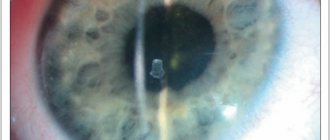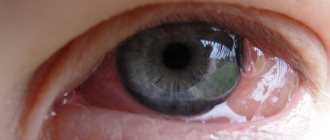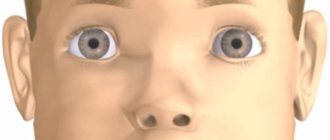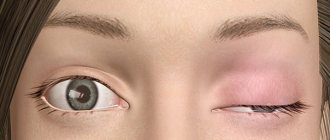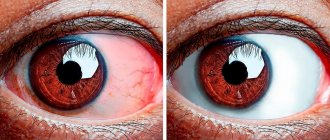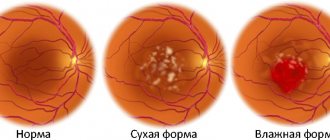The health of the visual organs is the main guarantee of clear perception of the surrounding world. Aging also affects the eyes, often leading to such unpleasant consequences as age-related farsightedness or presbyopia. This condition creates discomfort, and therefore the issue of prevention and correction of this pathology is quite acute today.
Upon reaching a certain age, usually between 45-50 years, serious changes begin to occur in the human body. Of course, they can begin earlier - it all depends directly on immunity, lifestyle and the presence of chronic
In this article
- What is presbyopia?
- The main symptoms of age-related farsightedness
- Causes of age-related farsightedness
- Diagnosis of age-related farsightedness
- What do you need to know about vision correction for presbyopia?
- Spectacle correction of presbyopia
- Vision correction for farsightedness using lenses
- How to correct farsightedness using physiotherapeutic methods?
- Surgical treatment of farsightedness in adults
diseases. It is not surprising that similar changes affect vision. What pathologies can cause deterioration in visual functions at this age, is it possible to eliminate them in a timely manner, and most importantly, to permanently recover from age-related farsightedness?
What is presbyopia?
Presbyopia, which is often called “senile” farsightedness, is an ophthalmological disease; its development directly depends on how old a person is, whether he has had any eye injuries during his life, etc. Presbyopia consists in the fact that objects located at a close distance cease to be bright and contrasting. Can this condition be corrected or not? As ophthalmologists assure, the degree of development of this pathology depends on the state of the visual apparatus of each individual person. The degree of deviation of farsightedness in adults can be different and directly depend on what vision was previously. It is important to understand that presbyopia is a typical manifestation of vision impairment. Age-related farsightedness can easily be compared to the appearance of gray hair or wrinkles on the face. Throughout our lives, the resources of cellular regeneration are exhausted, and therefore we should not expect that the lens or the muscles of the eye will be able to maintain their previous state without needing correction.
What ophthalmologists say about age-related farsightedness
“The development of farsightedness after 40 years is not a disease, but a natural, predictable process,” say modern ophthalmologists. Here are their answers to some questions about presbyopia.
— At what age can you expect the appearance of farsightedness, and what is this connected with?
The first signs of presbyopia appear after 40 years. The disease is associated with age-related changes in the tissues of the eye, which over the years lose their elasticity and ability to focus vision. This is as normal and predictable as changes in skin condition under the influence of the aging process.
— Is it normal for age-related farsightedness to progress?
People of the same age look different: some are younger, some are older. Some have trained muscles, others have flabby muscles. It's the same with vision. Typically, the ability to see close objects begins to gradually decline after age 40. This process continues until age 60, when a correction of 3 diopters (plus three) is required.
On average, a person with normal vision at 40 years old requires glasses plus one, at 50 - plus two, at 60 - plus three. But this depends on how well the intraocular muscles that focus the gaze are trained.
— So, the appearance of age-related farsightedness can be delayed?
Exercise and good nutrition are important. But much depends on the conditions in which a person works, writes, reads. Comfortable conditions for the eyes, even with constant visual stress, allow you to maintain good vision longer.
— How effective are the “hole” glasses that are sold in pharmacies?
Punch glasses help relieve tension for a short time. They provide good vision for small changes in refraction, and some people use them instead of regular glasses. But these glasses are simulators. They should be worn for a short time. With prolonged use, irritability and discomfort may occur.
— Some people are afraid that wearing glasses with diopters can accelerate the deterioration of vision. Is there such a danger?
This myth prevents many people from seeing a doctor on time. First of all, the right glasses only help your eyes. Secondly, whether you wear glasses or not, age-related changes will continue, and after 60 years, people with normal vision will in any case need glasses of three diopters. But those who have worked towards this, gradually strengthening their glasses, will keep their eyes in better shape.
— What is better: choosing glasses that are a little weaker than necessary, or vice versa?
It all depends on the specific situation. For example, in some cases when glasses plus two are needed, and a person has never worn glasses, it will be difficult for him to get used to them right away. It is especially difficult in the first days. Therefore, the doctor recommends milder intermediate options. But there are many nuances, and in each case the glasses are selected individually.
— With the appearance of farsightedness, myopia with which a person has lived all his life often disappears. Does it happen that they coexist?
If myopia is less than three diopters, then closer to sixty years of age you may need reading glasses with positive lenses.
The main symptoms of age-related farsightedness
The first symptoms of age-related farsightedness arise, as a rule, due to the loss of the eye's lens of its former elasticity. In more detail, the organic biconvex lens that is required to provide focal length is renewed throughout life. A healthy lens is composed of unique transparent fibers and is easily able to change curvature using the ciliary muscle. That is why it becomes possible to clearly see objects located both at close range and at a certain distance.
As a rule, upon reaching the age of 45-50 years, a dense core may form inside the lens, which gradually becomes sclerotic, thereby preventing the flexibility of the lens. Another cause of age-related farsightedness can be wear and tear of the ciliary muscle and ciliary girdle, which are the main elements in the functioning of the lens.
Causes
Its occurrence is associated with physiological aging of the body. It occurs regardless of whether the person wore glasses or did without them. The appearance of this disease is a normal process that is inevitable and can be corrected with the help of modern ophthalmological means. There are several reasons for age-related farsightedness. It mainly occurs due to age-related changes in the lens itself.
- sclerotic changes occur, due to which the eye is less well supplied with blood, which leads to the fact that the eye does not receive the necessary nutrition, and begins to see worse
- The curvature of the lens changes, its capsule and core become denser, the lens loses elasticity
- the supporting function of the muscle responsible for focusing vision weakens, more time passes for the image on the retina to become sharp and clear
- The ciliary muscle weakens and dystrophy occurs.
What happens in the eye?
With normal and healthy vision, light rays travel parallel from distant objects and are collected precisely on the retina.
If the object is located close, the beam of rays diverges, the eye needs a higher refractive power. In a healthy eye, this happens automatically; the lens easily transitions from distance to near vision. With presbyopia, this function gradually weakens. In fact, changes occur in the lens itself, its structure changes, it becomes less elastic and can no longer change shape when focusing at a close distance. This condition distinguishes age-related farsightedness from other types of farsightedness and other visual impairments, which can be genetic, congenital or acquired.
The maximum elasticity of the lens is observed in childhood; over the years it decreases, and by the age of 60-65 it becomes minimal.
Causes of age-related farsightedness
As ophthalmologists assure, the development of farsightedness with age is very difficult to resist. The fact is that already after reaching the age of 30, the ability of the visual organs to accommodate begins to decrease by almost half. After another 10 years - by 2/3, and after 50 - it is completely lost. Deterioration of vision with age-related farsightedness occurs mainly due to the following circumstances:
- the patient has a history of hypermetropia, especially moderate degrees: from +3 to +5;
- various types of ophthalmological injuries, as well as eye pathologies of an inflammatory nature;
- professional activity that involves regular work at the computer;
- chronic diseases, for example: diabetes, hypertension, neurological pathologies, etc.
Diagnosis of age-related farsightedness
In order to promptly begin treatment of farsightedness in adults, an ophthalmologist needs to carry out certain diagnostic procedures. Such an examination, done using modern techniques, will confirm the presence of one or another degree of the disease, as well as select the most appropriate correction method. The following procedures will help determine a pathology such as age-related farsightedness:
- visometry, during which the patient is asked to examine letters of different sizes depicted on a poster;
- ophthalmoscopy - examination of the fundus, retina, optic nerve and vascular network;
- refractometry - measurement of clinical refraction of the visual organs, carried out using a refractometer;
- tonometry, which consists of measuring intraocular pressure;
- biomicroscopy - examination of the internal structure of the eyes using a slit lamp;
- Accommodation study - conducting certain texts, including proximetry, ergography and accomodometry.
Farsightedness - symptoms and treatment
There are two types of diagnostic methods for farsightedness - visometry and refractometry.
Visometry is the assessment of visual acuity using tables for distance and near.
Most farsighted patients do not lose visual acuity with a mild degree of the disease. In people with moderate and high degrees of hyperopia, this ability is impaired much more often, especially with regard to near visual acuity. Such patients usually complain of fatigue when working at a computer and reading books, redness, sore eyes and even headaches.
The degree of compensation for farsightedness is influenced by the strength of the ciliary muscle. This indicator is individual. For example, in clinical practice there have been cases of absolute compensation for distance with farsightedness of 7-9 diopters. This creates quite a few problems for both parents and doctors during the examination. I propose to briefly analyze this situation.
Parents brought a 6-year-old child for a pre-school examination. Visual acuity is 1.0 for distance and 0.8 for near. The child was able to read 100% of the table. In this case, most often they let him go and convince his parents that everything is fine. But this doesn't always happen.
If you follow a routine examination protocol and examine the balance of the extraocular muscles, then sometimes with normal visual acuity you can notice hidden strabismus, convergence disorder, and when studying refraction in the active state, an increase in diopters of both eyes.
Hidden strabismus in such cases can be detected by instilling cyclopentolate or atropine sulfate into the eyes three times an hour. Phenylephrine and tropicamide are not suitable for this. Sometimes, under the influence of drops, the eyes seriously deviate towards the nose. This suggests that soon the hidden strabismus will become obvious.
Hundreds of patients find themselves in a similar situation. Unfortunately, for various reasons, such farsighted children are noticed only after obvious problems arise with the position of the eyes in the orbit. Although farsightedness and complications that arise can be detected much earlier. To do this, it is important to check the acuity of both eyes and conduct other tests in addition to checking visual acuity using a chart.
Refractometry and/or retinoscopy [9] (skiascopy) are instrumental diagnostic methods. They determine the number that will eliminate refractive error in the eye.
The technology for obtaining this number is complex. When refractometry is necessary to determine the refractive index and its functions. This method is more reliable compared to retinoscopy[10].
If, with farsightedness, the ciliary muscle, which helps a person see well, is in working order, then refractometry will give distorted indicators. To prevent this muscle from interfering with the diagnosis, it must be forcibly turned off using drops to “dilate the pupil.” But here an error may occur.
How do you know if the diagnosis is correct?
There are two ways to dilate the pupil:
- mydriasis - dilation of the pupil, almost without affecting the muscle;
- cycloplegia - relaxation of the muscle, which indirectly leads to dilation of the pupil.
Mydriasis occurs quickly, as do its consequences. It is necessary, rather, for examining the fundus. Cycloplegia is not so easy to achieve; the consequences take several days, sometimes weeks, to eliminate. It is required to assess refraction without muscle intervention.
The correct determination of refraction depends on which method of pupil dilation is chosen. If instead of cycloplegia mydriasis was performed, then the treatment will be structured incorrectly. When such conservative treatment does not produce results, some doctors talk about the need for surgery or, worse, diagnose optic atrophy.
What do you need to know about vision correction for presbyopia?
Many people who have heard such a diagnosis as “age-related farsightedness” are concerned with the question: is it possible to correct the current situation? Trying to find the answer and choose the most suitable vision correction for themselves, many begin to study thematic sites and forums. We strongly do not recommend that you try to correct farsightedness using miracle eye drops or any other medications.
First of all, you need to make an appointment with an ophthalmologist who, based on the results of the examination, will be able to choose the most effective treatment for you.
It is very important to understand that if age-related (“senile”) farsightedness progresses, then vision correction should be comprehensive and purely individual. You should not spend extra money on medical drugs and eye trainers without even finding out whether they are suitable for you - this can damage your vision even more.
Spectacle correction of presbyopia
One of the most effective ways to correct presbyopia is to use glasses with “plus” diopters. Depending on the degree of age-related farsightedness, treatment can be carried out in different ways. Some people need vision correction during work, while others, on the contrary, need it after work, for example, while reading or watching TV. The best option for people suffering from this pathology and wanting to correct age-related farsightedness are glasses with progressive lenses. They do not have a clear boundary between zones, which makes them even more comfortable in everyday use. Bifocal models are considered a more outdated option.
Is it possible to get rid of age-related farsightedness surgically?
It is not possible to surgically restore the elasticity of the lens, but there are methods that help correct vision and stop using glasses or contact optics.
Laser thermokeratoplasty.
The method is based on the thermal effect of radio waves, with the help of which the refractive surgeon changes the shape of the patient's cornea. For age-related farsightedness, the procedure is most often performed on one eye to “tune” it to good near vision. This is the same as monovision, but without the use of glasses or contact lenses.
Replacement of the lens with an intraocular lens.
This method of treatment is the most radical and is most often used when presbyopia is accompanied by cataracts. Also, this method can be considered as the prevention of cataracts, because the artificial lens, unlike the real one, cannot become cloudy.
Modern technologies make it possible to perform such operations under local anesthesia through a minimal self-sealing incision that is closed without stitches. The procedure lasts about 20 minutes, and the patient usually goes home the same day. Multifocal or accommodating intraocular lenses are usually used to correct presbyopia. The first, by analogy with multifocal contact lenses, have several optical foci, allowing a person to see well at different distances. The second has a special “moving” design that uses the muscles of the eye and reliably imitates the focusing ability of the natural lens.
PresbyLASIK.
This is the latest method of treating age-related farsightedness, which is based on the use of an excimer laser. With its help, the surgeon models the surface of the cornea such that different areas of the eye will have different optical powers. An ophthalmologist will tell you which method of correcting presbyopia will be optimal for you.
Vision correction for farsightedness using lenses
A more optimal and comfortable means of vision correction for many are contact lenses. In situations where a person suffers from “senile” farsightedness, ophthalmologists often prescribe multifocal models. Treatment of age-related farsightedness with their help guarantees clear vision, regardless of the distance between the eyes and the object. Developers of contact optics are able to achieve a similar effect for this pathology through innovative lens design. It is thanks to him that the user can clearly see all three zones: central, transitional and peripheral. If, based on the results of the examination, the doctor is convinced that vision correction with lenses for age-related farsightedness will be more than effective, then he can recommend such models as: Biofinity Multifocal, 1-Day ACUVUE Moist Multifocal, Air Optix Aqua Multifocal, Clariti 1 day Multifocal and other means of contact correction.
What does farsightedness mean?
Senile farsightedness is a completely natural phenomenon; it develops over the years as a result of disturbances in the eye apparatus and is characterized by the difficulty (impossibility) of the eye lens to focus on small objects located nearby. It becomes difficult to distinguish small text, read books and newspapers, but at a distance the same things are clearly visible.
The physiology of the lens allows it to change its refractive power, thus adapting to different conditions: to see close and far, in bright sun and in the dark. Over the years, the ability to accommodate is lost.
Causes of visual changes in adults after 40-45 years:
- the elasticity of eye tissue decreases;
- the amount of water in the tissues of the lens decreases;
- functional connective tissues are replaced, which leads to clouding of the lens and its inability to change its focusing angle;
- weakening of the muscles that form the supporting apparatus;
- dystrophy of the ciliary muscle.
Changes occur smoothly and, sometimes, completely unnoticed; much depends on the person’s physical health, hereditary predisposition, and preventive measures regarding vision. After 30 years, the ability to accommodate the lens decreases by approximately half, after 40 - by 60-65%, after 60 years - completely.
Normally, age-related farsightedness develops as follows:
- Normal refraction, without deviations towards myopia or farsightedness, is called emmetropia. The first disturbances become noticeable by the age of 40-44, the eyes quickly get tired, brighter lighting is required for reading and work, objects located in the distance are seen more clearly. There may be lacrimation, pain above the eyebrows, in the bridge of the nose.
- If a person was diagnosed with farsightedness at a young age, then its symptoms become more pronounced earlier than at 40 years of age. Violations appear already by the age of 30, and hyperopia (increased farsightedness) interferes with viewing objects both near and far.
- If a person is diagnosed with myopia - myopia, then age-related farsightedness will affect him later than usual. The inability to see in the distance is, as it were, compensated over time and allows you to do without special glasses; with severe myopia, vision becomes “normal” over the years.
How to correct farsightedness using physiotherapeutic methods?
In recent years, vision correction for presbyopia using physiotherapeutic methods has not been as popular as it should be. Is it possible to treat age-related farsightedness in this way? This question is asked by many patients today. It is safe to say that it is impossible to get rid of it forever. But as a concomitant treatment, physiotherapeutic methods are very effective. These include:
- vacuum massage;
- use of special glasses for training;
- laser or ultrasound electrical stimulation.
The mechanism of occurrence of senile farsightedness
- 4.1 Bifocals
- 5.1 Mono correction
In youth, the lens of the human eye exhibits constant elasticity. It can easily change shape if necessary. This feature allows people to perfectly distinguish objects that are at different distances. Over time, the lens gradually hardens, limiting its flexibility. The ability to actively change shape is lost, the person switches attention more slowly from one object to another. In this case, the ability to focus attention on objects located nearby almost completely disappears.
Gradually, a person notices that reading books with small text or doing routine housework that requires close attention becomes much more difficult. It should be remembered that age-related farsightedness (presbyopia) differs from such a pathology that arose at a young age. In the first case, the loss of the ability to see well near is affected by the hardening of the lens, and in the second, the person suffers from altered contours of the cornea or the eyeball itself.
Difference between normal vision and presbyopia
To temporarily eliminate the negative manifestations of age-related farsightedness, many people use special glasses. This is the simplest and most convenient way to temporarily relieve negative symptoms. Some act radically, resorting to surgical intervention. You can use the refractive method of inserting an artificial lens by placing an intraocular lens instead.
Laser correction
Sometimes the patient decides in favor of surgical vision correction. In modern medicine there are several ways to perform such an operation, so one of the following manipulations is selected according to indications:
- Laser thermokeratoplasty. This is a method of getting rid of presbyopia using radio waves, which, when used in doses, can bend the cornea of the eye into the required shape.
- LASIK. The cornea is subjected to a radical effect using laser radiation.
- Implantation of an artificial lens.
Laser correction
When choosing a laser as the main method for correcting age-related farsightedness, the following types of surgical intervention are distinguished:
| Variety | Description |
| Creating monovision | This is a corneal correction for one eye only. The operation is performed on two eyes, however, due to the technical features of the development of presbyopia, one can see better only near, and the second is adapted to view objects at an impressive distance |
| Creation of a multifocal cornea | The laser changes the shape of the cornea so much that it has 2 foci. At the same time, the eyes will also see differently: one near, and the other at a long distance |
Lensectomy (lens renewal)
Used to get rid of advanced cases of farsightedness. The essence of the method is to remove the transparent lens due to a change in its optical power. Instead, an intraocular lens is installed, selecting the exact size of the implant.
Inserting phakic lenses
Used when the patient loses accommodation. In this case, the lens is not removed, but the lens is placed in one of the chambers of the eye. To perform the operation, the doctor makes a small incision, which does not require stitches in the future. Typically, lenses are placed behind the iris without special fixation.
Surgical treatment of farsightedness in adults
As you probably guessed, the most radical and effective way to correct the visual impairment that we are talking about in this article is surgery. For example, using LASIK, ophthalmic surgeons can change the curvature of the cornea of the eye. Often, if “senile” farsightedness develops, ophthalmological practice resorts to complete replacement of the lens with an intraocular lens - a special implant that will replace this organ. Of course, discomfort during surgery cannot be completely ruled out, but in comparison with similar procedures, it is classified as minimally invasive.
Age-related eye diseases
With age, the risk of developing certain ophthalmological diseases increases, which can lead to complete loss of vision. Therefore, after 40 years, it is very important to be systematically examined by a specialist.
Glaucoma
Glaucoma develops as a result of increased intraocular pressure. This pathological condition leads to damage to the optic nerve and, accordingly, to deterioration of vision, up to its complete loss. This disease is distinguished by its insidiousness, since it does not manifest itself for a long time. At risk are people who have a hereditary predisposition to developing the disease and people over 40 years of age.
Some symptoms should alert you: pain, discomfort and pain, the appearance of “floaters” and fog before the eyes, deterioration of vision in the dark. Both eyes are affected, but alternately.
Treating glaucoma is very difficult and the outcome is usually unfavorable. But you should not ignore the disease, since a timely visit to the doctor may not help to completely restore vision, but it will preserve the visual functions that have not yet been lost for several years.
Cataract
Another, no less dangerous, ophthalmological disease can have symptoms similar to glaucoma. Cataracts occur due to clouding of the lens (impaired transparency). People over the age of 40 are at risk, and by the age of 80 its occurrence is completely inevitable.
Unlike glaucoma, cataracts are easier to treat. The most effective method is surgery. In addition to surgery, the patient is also prescribed drug therapy.
Presbyopia
Another disease that begins to worry people after 40 is presbyopia (age-related farsightedness) of the eye. Damage to the lens, as well as its hardening, contribute to the development of this disease.
The main symptoms of presbyopia: difficulty reading texts written in small print, fatigue, blurred images and incorrect perception of objects (their sizes), headaches.
In this case, they try to improve vision using optical means. When it rapidly worsens, a specialist may set a date for surgery to replace the lens.
Diabetic retinopathy
Diabetic retinopathy develops in almost every diabetic patient (especially if the disease lasts more than 10 years). Increased blood sugar negatively affects the condition of blood vessels and the retina of the eye.
The disease manifests itself with the following symptoms: visual acuity decreases, the perceived image is distorted, “spots” and spots appear before the eyes. Treatment depends on many factors. Laser photocoagulation is most often used, and a number of drugs are prescribed. One of the most dangerous and likely complications is complete loss of vision.
